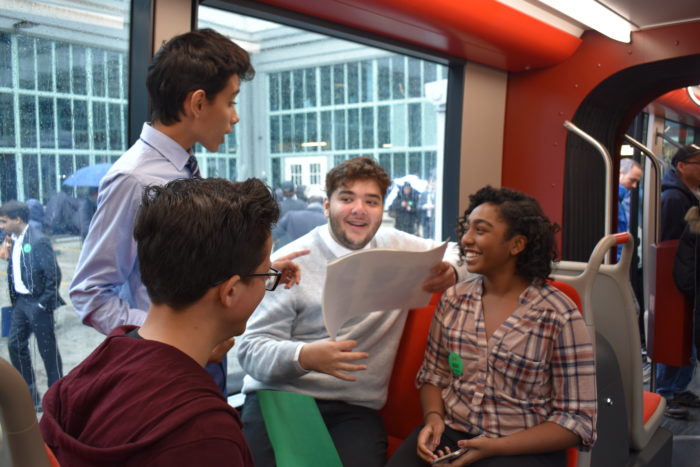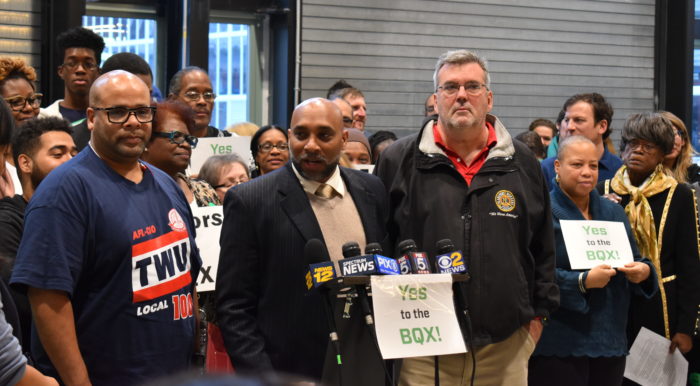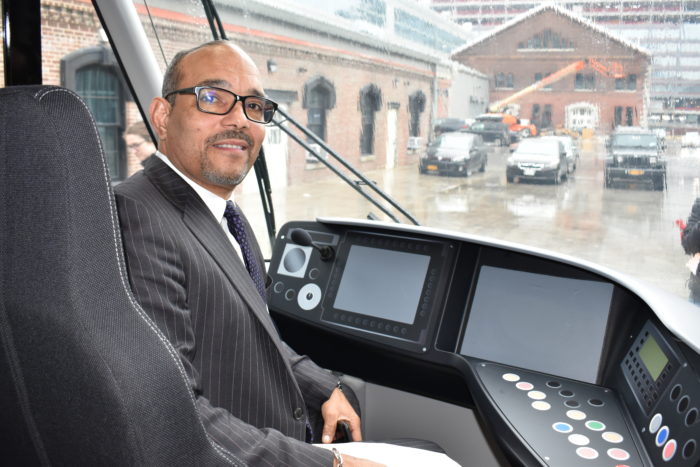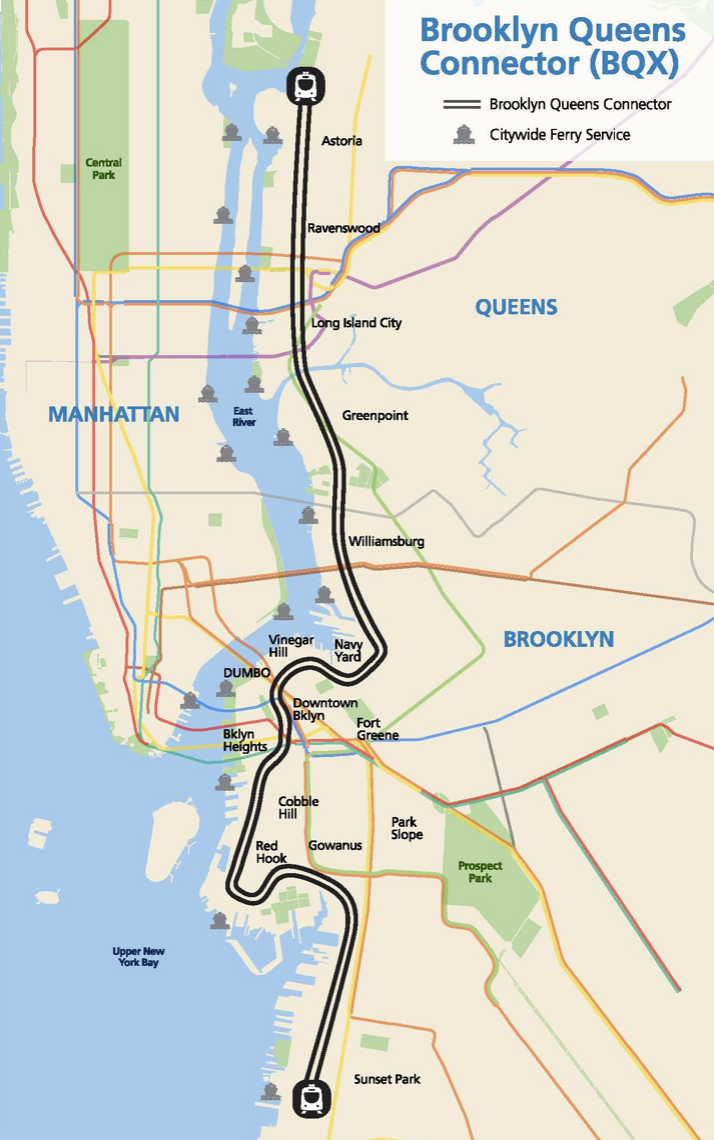A couple of the most crowded train cars in Brooklyn this morning, at least for a few minutes, were two that had no wheels. Yet the passengers were pleased anyway, since the vehicle they boarded was a life-size prototype of the proposed BQX streetcar, on view for the first time. Advocates of the streetcar, Friends of the Brooklyn Queens Connector, unveiled the mockup at the New Lab technology space in the Brooklyn Navy Yard, a likely site for stops along the proposed 14-mile route from Sunset Park to Astoria, Queens. The 46-foot-long, 8.7-foot-wide prototype featured several modern touches, including roomy gangways and street-level boarding to help the mobility-challenged.
Business leaders, politicians and citizen advocates squeezed into the space to see the futuristic-looking prototype and voice their support. “I come from a community where you have to walk ten blocks to reach the nearest subway. We are effectively cut off,” said Claudia Coger, the resident-association president at the Astoria Houses, part of the city’s Housing Authority. “Our residents have to struggle to reach the opportunities available to so many others,” she told the crowd.
Queens Borough President Melinda Katz described Queens as “a transit desert. Two thirds of our borough is not covered by subway.” Katz endorsed the BQX as part of an expanded transit system with many modes, including subways, ferries and bike lanes. “Right now the most important thing is to make sure we can move New Yorkers from borough to borough to borough.”

Students who brought signs declaring their support tried out the seats inside the full-scale mockup
Several speakers pointed to the rapid redevelopment of the Brooklyn-Queens waterfront as the major rationale for building the proposed $2.5 billion system, connecting work centers including Industry City, the Navy Yard, Williamsburg and Long Island City. When the city recently pitched sites for Amazon’s proposed second headquarters, two of the four suggested sites were Long Island City and the Brooklyn Tech Triangle, which includes Downtown Brooklyn, Dumbo and the Navy Yard. “The tech sector is moving in, but struggles with transportation,” said Manhattan-based venture capitalist Fred Wilson, who chairs Tech:NYC, a nonprofit that advocates for the city’s tech industry.
Backers of the light-rail project estimate that it would serve more than 400,000 residents along the route, as well as 300,000 workers in the corridor. While Brooklyn and Queens have multiple subways running along east-west routes, New Yorkers heading north or south along the rapidly developing waterfront corridor have few options, notably the suddenly vital G train. “If you think about it, our subway system was built 100 years ago, when Manhattan was the center of the universe,” said Ya-Ting Liu, executive director of Friends of the BQX. “We are so confident that this mode of transportation is really going to be a game-changer.”

Representatives of the Transit Workers Union, which has endorsed the BQX, addressing the crowd at the unveiling
Since February 2016, when Mayor de Blasio announced the BQX proposal from the transit-starved neighborhood of Red Hook, a host of supporters have climbed aboard, including major employers, politicians, environmental advocates, and the Transit Workers Union. Who, then, is against it, or at least asking tough questions? The critics include residents who worry about the streetcar’s right-of-way taking up traffic lanes and parking spaces, people who think the money would be better spent on initiatives like expanded bus routes in Queens, and others who feel that it will hasten the gentrification of working-class and low-income neighborhoods like Sunset Park. (One group even made an 18-minute video expressing its objections.) At today’s event, Borough President Eric Adams said, “I fully support this project,” but acknowledged the debate and emphasized that the BQX will need a lot of community involvement to shape it and keep it moving. “People are raising questions about different aspects. These are great questions,” Adams said. Paraphrasing Brooklyn native Jay-Z, he added, “We have 99 problems and 101 solutions from people telling you how.”

The prototype included a mockup of the driver cab
While the viability and technology of light rail has been amply demonstrated in such U.S. cities as Minneapolis-St. Paul and Portland, Ore., installing a 14-mile system in a city as old and complex as New York raises major logistical challenges: routes, utility lines in the way, and financing methods. All are being explored in a feasibility study commissioned by the city. In April, a leaked memo prepared by the mayor’s BQX project team noted that a potential concern is the financing method “not providing sufficient revenue to fund the entire project as originally stated.” However, de Blasio said in an interview later the same month, “We believe this is a vision that can work and can work on time.”
Indeed, persuading the mayor to fully commit his political capital to the project during his second term was evidently one of the goals of bringing the streetcar prototype to Brooklyn. Said Ya-Ting Liu: “We call on the city of New York and the mayor to take action and move this program forward.” While today’s showing was a one-day event, Friends of the BQX is looking into ways to display the streetcar again in the coming year, according to a spokesman for the group.
The project should appeal to the mayor’s oft-stated goal of creating 100,000 good jobs over the coming decade. Advocates of the streetcar noted that the Navy Yard alone is projected to add 10,000 new jobs in the next three years, thanks to expansion at the 300-acre site. The project could conceivably bring jobs to New York State as well. The prototype was build by Alstom, a French company that has a major train-manufacturing plant in upstate Hornell, N.Y., that is producing the next generation of high-speed trains for Amtrak.

The route study area spans from Sunset Park to Astoria, Queens (Map by the New York City Economic Development Corp.)